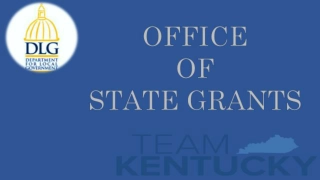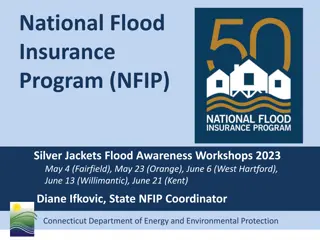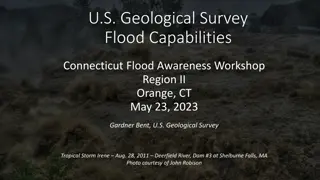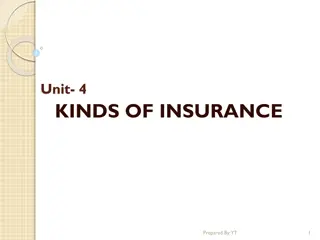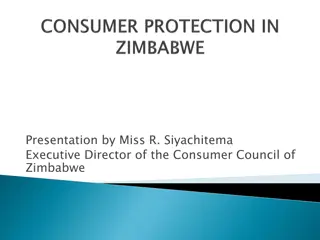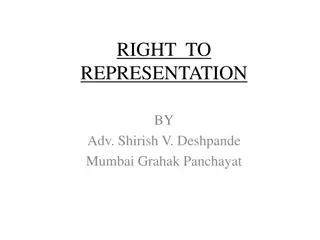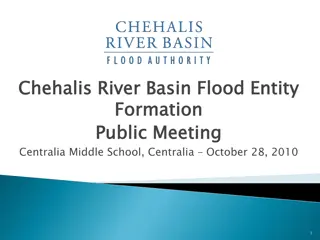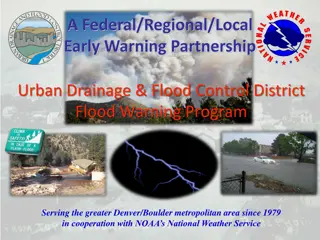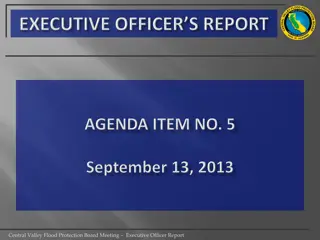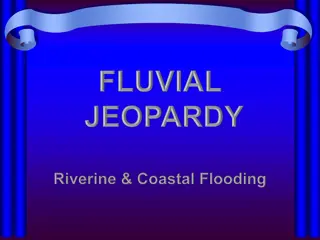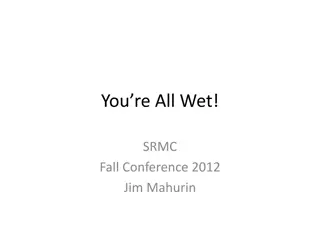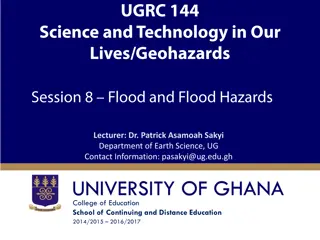Consumer Flood Insurance Market Overview
Natural disasters impact consumers significantly, necessitating flood insurance coverage. Climate change exacerbates these catastrophes, highlighting the need for accessible insurance solutions. Practical challenges exist in managing flood and earthquake risks, requiring innovative approaches like those seen in New Zealand's statutory scheme. By studying successful models and adapting them, the emerging consumer catastrophe insurance market can provide essential protection for individuals and communities.
Download Presentation

Please find below an Image/Link to download the presentation.
The content on the website is provided AS IS for your information and personal use only. It may not be sold, licensed, or shared on other websites without obtaining consent from the author.If you encounter any issues during the download, it is possible that the publisher has removed the file from their server.
You are allowed to download the files provided on this website for personal or commercial use, subject to the condition that they are used lawfully. All files are the property of their respective owners.
The content on the website is provided AS IS for your information and personal use only. It may not be sold, licensed, or shared on other websites without obtaining consent from the author.
E N D
Presentation Transcript
CONSUMER FLOOD INSURANCE some thoughts for an emerging consumer catastrophe insurance market Johanna Hjalmarsson Mateusz Bek
BACKGROUND Natural disasters are inevitable, unpreventable, often come without warning and tend to affect the lives of large numbers of consumers. Although they can be mitigated against, their impact upon the society cannot be avoided. Climate change has been intensifying the occurrence of natural catastrophes over the past few decades. Availability of insurance is, therefore, crucial in helping people to restore what they lost because of a natural hazard.
Practical issues Flood risks get progressively worse as the ground is saturated with water Earthquake risks build up over time and release over a short period of time, often with ancillary risks such as tsunamis or landslides Large and widespread destruction cannot be catered for in a regular government budget Government needs the insurance industry but these risks may look inevitable and therefore uninsurable or at least unattractive to commercial insurers
Our project Statement of Principles expires 30 June 2013 Our project aims to study solutions already in place in other jurisdictions and analyse whether those solutions can be adopted in the UK and provide a comprehensive report The report will aim to provide neutral information for policymakers and the market Further information: public policy @ southampton Insurance Law Research Group at UoS
NEW ZEALAND New Zealand introduced a statutory scheme of insurance against natural catastrophes as early as in 1944. It was subsequently revised by the Earthquake Commission Act 1993, whereby the Earthquake Commission (EQC) was established. Every person who enters into a contract of fire insurance with a private insurance company in respect of a residential building is deemed to have insured that building against natural disaster damage for the replacement value to the amount specified under the act, not greater than $100,000 per dwelling. However, there is no contractual relationship between the assured and the EQC liability is statutory in nature.
NEW ZEALAND Although designed to deal predominantly with the aftermath of earthquakes, which are common there because of the peculiar location of the country, the scope of the act is much wider. Person insured under the EQC Act 1993 can additionally obtain a top-up cover on the private market. Commercial property is excluded from the ambit of the EQC Act 1993. The EQC has a reinsurance programme in place in the form of an excess of loss policy. Success of the scheme depended largely on the market penetration of fire insurance.
Turkey - background Prior to the establishment of the Turkish Catastrophe Insurance Pool (TCIP) in 1999, Disaster Law No 7296 required the government to finance reconstruction of households destroyed by a natural disaster. From the very beginning, the Turkish government was of the opinion that leaving catastrophe insurance coverage to consumer choice was simply not a viable solution in a country with extremely low insurance penetration level.
Turkey - TCIP TCIP was made the sole provider of coverage against earthquake risk up to an initial amount of $25,000 (currently, $83,400), yet private market can top-up . Earthquake insurance offered by the TCIP is sold as a stand-alone product. The Turkish government rejected the idea implemented in New Zealand, namely combining fire insurance policy with a natural catastrophe cover.
Turkey - obstacles Lack of awareness among citizens about the existence of the pool proved to be the main obstacle to uniform implementation of the new legislation. Lack of risk awareness was yet another problem. Lack of trust in the TCIP was an additional issue people viewed, and to large extent still do view, the pool as a tax levied by the government.
Turkey - structure Unlike in the case of New Zealand, where a flat premium rate applies to all properties concerned, the TCIP premium levels vary from 0.44% to 5.50%, depending on the type of construction of the particular building and the earthquake zone in which it is located. Reinsurance, in the form of excess of loss, is also in place. Recent data suggest the program has not been entirely successful.
CONCLUDING REMARKS Cover against natural disaster damage is essential in today s society, especially in regions known to be regularly affected by such hazards. The two models studied so far in the project demonstrate some of the challenges encountered in developing efficient natural disaster cover. None of the presented models should be transposed in entirety into the Chinese legal system. Nonetheless, lessons can be learnt, so as to improve on the existing solutions.



